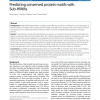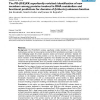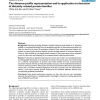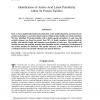JCC
2011
12 years 7 months ago
2011
: Docking is one of the most commonly used techniques in drug design. It is used for both identifying correct poses of a ligand in the binding site of a protein as well as for the ...
BMCBI
2010
12 years 11 months ago
2010
Background: Profile HMMs (hidden Markov models) provide effective methods for modeling the conserved regions of protein families. A limitation of the resulting domain models is th...
BMCBI
2005
13 years 4 months ago
2005
Background: Detection of sequence homologues represents a challenging task that is important for the discovery of protein families and the reliable application of automatic annota...
BMCBI
2005
13 years 4 months ago
2005
Background: Current protein clustering methods rely on either sequence or functional similarities between proteins, thereby limiting inferences to one of these areas. Results: Her...
BMCBI
2005
13 years 4 months ago
2005
Background: The PD-(D/E)XK nuclease superfamily, initially identified in type II restriction endonucleases and later in many enzymes involved in DNA recombination and repair, is o...
BMCBI
2005
13 years 4 months ago
2005
Background: Detecting homology between remotely related protein families is an important problem in computational biology since the biological properties of uncharacterized protei...
JCB
2006
13 years 4 months ago
2006
Here, we have applied information decomposition, cyclic profile alignment, and noise decomposition techniques to search for latent repeats within protein families of various funct...
BMCBI
2007
13 years 4 months ago
2007
Background: The pyridine nucleotide disulfide reductase (PNDR) is a large and heterogeneous protein family divided into two classes (I and II), which reflect the divergent evoluti...
BMCBI
2006
13 years 4 months ago
2006
Background: The emerging field of integrative bioinformatics provides the tools to organize and systematically analyze vast amounts of highly diverse biological data and thus allo...
GECCO
2005
Springer
13 years 9 months ago
2005
Springer
Choosing the right representation for a problem is important. In this article we introduce a linear genetic programming approach for motif discovery in protein families, and we al...




